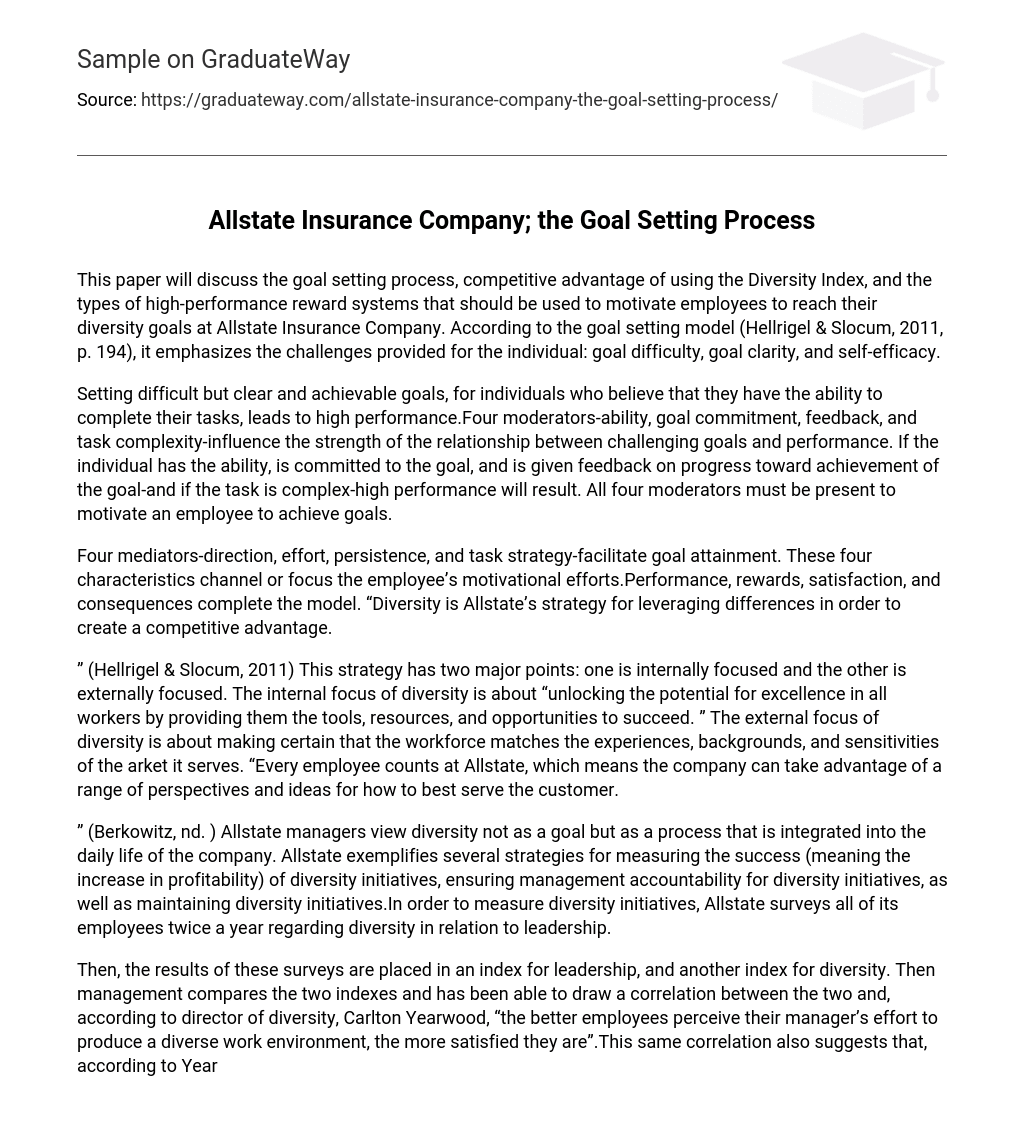The aim of this paper is to examine the process of goal setting, the competitive advantage of using the Diversity Index, and the recommended high-performance reward systems to motivate employees in achieving diversity goals at Allstate Insurance Company. The goal setting model (Hellrigel & Slocum, 2011, p. 194) emphasizes the individual’s challenges such as goal difficulty, goal clarity, and self-efficacy.
Setting challenging but attainable goals for individuals who have confidence in their abilities can lead to exceptional performance. There are four factors that impact the strength of the connection between demanding goals and performance: ability, goal commitment, feedback, and task complexity. When an individual possesses the necessary skills, is dedicated to the goal, receives feedback on their progress, and is faced with a complex task, high performance is likely to occur. It is essential for all four factors to be present in order to motivate an employee to accomplish their goals.
Four mediators (direction, effort, persistence, and task strategy) aid in achieving goals. These mediators help focus the employee’s motivation. The model is completed by performance, rewards, satisfaction, and consequences. Allstate sees diversity as their strategy to harness differences for a competitive advantage.
“(Hellrigel & Slocum, 2011) This strategy has two main aspects: an internal focus and an external focus. The internal focus of diversity is centered around providing employees with the necessary tools, resources, and opportunities to excel. The external focus of diversity aims to ensure that the workforce reflects the experiences, backgrounds, and sensitivities of the market it serves. Allstate values every employee, recognizing that their diverse perspectives and ideas contribute to serving the customer in the best possible way.”
“(Berkowitz, nd.) Allstate managers consider diversity not as a mere objective, but as an ongoing practice integrated into the company’s day-to-day operations. Allstate demonstrates multiple approaches to assess the effectiveness (i.e., the growth in profitability) of diversity initiatives. These approaches include holding management responsible for diversity efforts and sustaining diversity initiatives. To gauge the impact of diversity initiatives, Allstate conducts biannual surveys among all employees to evaluate diversity in leadership roles.”
The surveys’ results are compiled into two indexes: one for leadership and another for diversity. Management compares the two indexes and has noticed a correlation. Carlton Yearwood, the director of diversity, states that the perception of a manager’s effort towards diversity affects employee satisfaction. Yearwood also suggests that higher scores on the leadership and diversity indexes increase the likelihood of customer policy renewals. Furthermore, Allstate links diversity initiatives to compensation, associating merit pay and bonuses with successful implementation and maintenance.
Allstate is committed to maintaining diversity initiatives. They make sure that all new employees receive diversity training within the first six months of employment. The training emphasizes the positive impact of diversity on the company’s bottom line. Allstate also offers extra support to managers on how to sustain a diverse and trusting environment. These strategies demonstrate the importance of measurement, accountability, and maintenance in successfully implementing diversity initiatives for profitability.
Allstate provides various programs to assist employees in maintaining a healthy work-life balance. These programs consist of an on-site child-care center, three nearby child-care centers with discounted services, and the Allstate Center for Assistive Technology (ACAT) which aids employees with disabilities such as carpal tunnel syndrome, mobility impairments, and multiple sclerosis. ACAT offers specialized assistance such as providing a customized home phone to an information technology employee who has trouble hearing during nighttime calls.
To incentivize and appreciate employees, I suggest incorporating informal rewards like sending personal notes to express gratitude for their hard work and timely completion of tasks. Additionally, introducing profit-sharing programs will allow the distribution of profits among employees. Furthermore, implementing skill-based pay programs will be advantageous as they focus on individual skills rather than the job itself, acknowledging and rewarding employees for their learning and growth. These programs ensure that employees are compensated based on their diverse range of skills. Moreover, considering flexible benefit programs would enable employees to select the benefits that are most important to them.
If I were employed at Allstate, the Diversity Index and Quarterly Leadership Measurement System (QLMS) would serve as motivating factors. These systems guarantee diversity training within six months of joining the company for new employees while providing managers with additional support in maintaining a diverse and trusting work environment. They also aim to strike a balance between work and personal life by offering facilities such as child-care and disability programs like ACAT. Lastly, these systems recognize the value of diversity in compensation by rewarding successful diversity initiatives with pay raises and bonuses.





